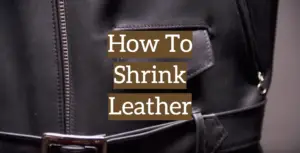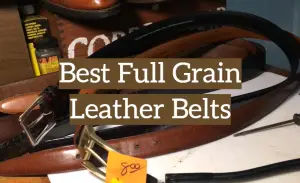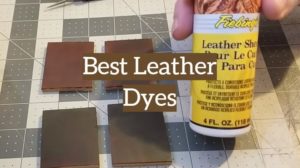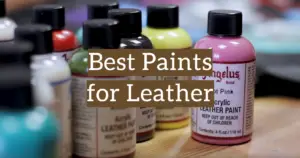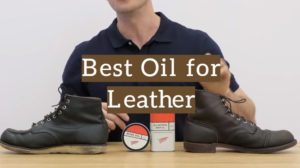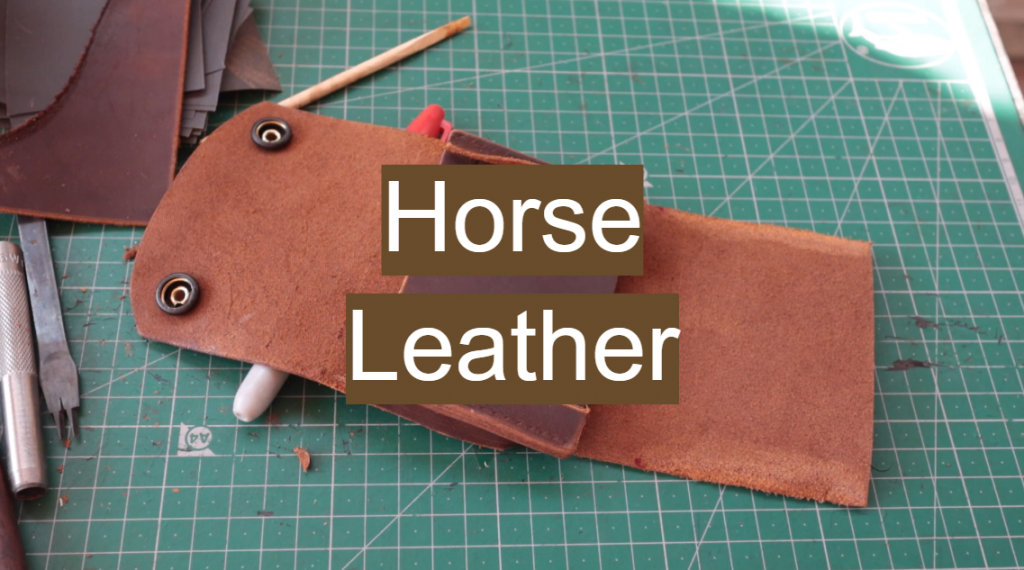
Horse leather (another name is Cordovan leather) is quite rare nowadays. Two circular parts have a strongly compressed fiber framework a few millimeters below the surface of the skin (butt or shell). In this area, the horse leather is especially dense and resistant. After the proper treatment, cordovan leather produces a lot of oils and greases. And that is why it is water-repellent.
These bits are about as wide as a sheet of paper. One of the most expensive leathers is Cordovan, especially when demand obviously exceeds supply. Appropriate horse hides are very scarce, since heavy horses are often very rare, and horses from breeding or athletic events may not be substituted. Hence, the raw material falls from a few specialty production firms. 75% of the skins are obtained from France and 25% from the Canadian province of Quebec. Though, the industry leader in Cordovan production is the United States.
Due to the vegetable tanning and the other production phases, the production period of Cordovan leather takes about 6 months. It becomes evident during the tanning process what skin parts will eventually be used for the development of shoes and which are more fitting for wallets or leather belts. After 60 days of tanning, the skin is dried on glass for four days and then hand-wiped with special oil. During the next 90 days of transit, this oil is absorbed fully into the horse leather’s top layer.
Its fine shine is a special attribute of Cordovan leather. This is created at the end of the manufacturing phase by glazing. The characteristic impact that may, however, be destroyed by the usage of incorrect shoe care items is generated by friction and fire. Therefore, maintain Cordovan shoes very cautiously and use only the items suggested by the maker of the shoes or cloth. Cordovan shoes have a very long lifespan if the standard of manufacturing is high and if they are handled properly.
The Cordovan leather at the end is very sleek and glossy. No visible roughness is present. You can just tell under the microscope that the transparent surface is the back of the cloth, but the leather is stretchable and comfortable.
Types of horse leather:
- Aniline. Due to the skin texture, horse aniline leather also has a particular finish;
- Pigmented horse leather. It is scarcely possible to differentiate pigmented horse leather from bovine leather;
- Shell Cordovan leather. This material is really sturdy and tough, and you can’t see the pores too thick to the human eye. They use the horse’s hindquarters to manufacture shoes with this type of leather. Naturally, Shell Cordovan is rather waterproof, but it is not impervious. It doesn’t crease – it ripples, a common feature of Shell Cordovan leather. Owing to the fact that the horse hides can’t be separated like cowhide and the tanning procedure is very difficult, it can take up to 6 months to tan the hides because of the vegetable tanning process involved. Shell Cordovan is a very expensive leather. This material lasts really well over the years and gets an impressive patina. The colors of most Shell Cordovan leather pieces are black, burgundy and orange. Thanks to its vivid luster, non-creasing grain character, great leather scent, longevity, and capacity to grow and sustain these characteristics over time, Shell cordovan is widely recognized as the finest leather in the world;
Horse leather vs cowhide
Horsehide leather isn’t inherently thicker than cowhide; both are sturdy, robust leathers and are well-tailored to working applications. Horse leather, though, is always stiffer than cowhide, though it requires a longer break-in period. Horse leather often has a coarser grain than cowhide, and many feel like it is brighter and shinier.
Horse leather is often less porous than cowhide, but the hue of colored horse leather appears to be less consistent. This may make horse leather impervious to water, but it’s not quite true. In certain instances, though, horse leather will need much less maintenance than cowhide, so less frequent applications will not be needed at the same pace for leather care items such as neatsfoot, mink oil or even mild saddle soap.
Will a gun holster/belt made of horsehide be safer than a cowhide holster? It might be a little stiffer but it would be better for either horse or cowhide belts than the belts made from rare leathers such as crocodile, lizard or ostrich.
Uses
Horse leather is typically used for making shoes and clothes since it is smooth leather. The most common uses of horse leather include:
Shoemaking
Horsehide is generally made up of 3 different products: the horse front, strips and shells. Two pieces for producing boots, the shells and strips, are the most common parts of horsehide.
Horse leather is primarily used for high-end accessories. Only the leather from the heavy workhorses’ rear flanks is sufficient. The front quarters and the back are a lot of horsehide padding since the rear quarters are mostly better adapted for heavy applications such as shoemaking. For instance, a rather common fashion item crafted from horsehide is Cordovan leather shoes; fine specimens demand hundreds of dollars per pair.
In the United States, where its processing method has been refined through the years, horse leather has its origins, though shoes made of this leather have been less common in Europe. Therefore, men’s shoes crafted from horse leather are manufactured by American shoemakers in particular.
Jackets
Horse leather is also manufactured into fashionable coats and jackets, in addition to being used for accessories. Since the market does not have much horse leather, not many jackets are made. The unique features of horse leather jackets are that they are typically thicker and stiffer than most leather clothing and are highly oiled or greased during leather processing. The leather jacket surface is smooth and without a significant grain structure. The jacket pattern is more in the tradition of early aviation jackets. Fans of horse leather jackets understand these characteristics exactly. Over time, with use, horse leather grows smoother and gets a distinctive patina. Such jackets are often worn at higher costs than new horse leather jackets. Usually, horse leather jackets are rigid and intensively oiled. But very soft horse leather jackets are also available.
Furniture
It is unusual to find furniture made of horsehide only. Though, there are a lot of furniture pieces with some horse leather pieces used for decorative purposes.
Accessories
Shell Cordovan leather is typically picked to produce small products like belts, cases, wallets, straps, covers for smartphones, etc.
Benefits:
- Nice texture;
- Fine gloss;
- Quite strong;
- Smooth;
- Won’t crack or crease;
The fibers are more compact in the horse’s rear than in steer fur, which is one explanation why Shell Cordovan is not cracking or creasing. More fibers suggest greater longevity, power, and versatility. The composition of the grain also suggests that horsehide appears to be more prone to abrasion than cowhide. Horseback is a heavyweight material, especially the strips, so it’s naturally dense and sturdy.
To highlight its best quality, horse leather requires adequate tanning and excellent craftsmanship. And its distinctive look separates it from more traditional leathers. And its longevity ensures it can shine on for longer than you’ll be around to appreciate it.
Care and maintenance
As you can expect, horse leather is a very fine-grained leather as horses have a perfectly soft hide. Cleaning has to be done with caution in conventional ways. Otherwise, the fibers of it may swell if they get soaked. For instance, to brush horse leather shoes you should use a gentle brush or rag – but it has to be dry. No wet cleaning is allowed. Just duff off using these tools. Wet cleaning may seriously damage the texture of horse leather.
The same results may also contribute to a classic leather procedure. Only products licensed for Cordovan should be used. With Colourlock Gloss Milk you may preserve the natural finish of horse leather. It maintains the shine and defends against drying. With a bit of this product, moisten a soft cloth and apply it in circular motions without intense rubbing. Then let it dry on its own, away from heat sources. The dullness that results is re-polished with a soft rag. Always try a new product in a discreet spot.
It may take time for horsehide leather to break-in and with use will become more supple and wrinkled. Never add a water repellent/sealant substance to any horse leather piece as natural leather requires breathing. Such chemicals can degrade the leather product’s look with age. In hot weather, store a horse leather jacket in a cool place.
Horsehide leather mostly has a velvet finish. That is why you should:
- Don’t grease it;
- Never apply wet cleaning;
- Never place something on the top of horse leather products;
You can weaken the surface if you use a liquid, paste or wax solution on one of my horsehide products, and it cannot be reversed.
Final thoughts
Horse or Cordovan leather is quite common in the United States. It is used by shoemakers and leather craftsmen to create really beautiful accessories. You should be careful when buying it – do not confuse it with cowhide. As for the maintenance, do not put anything on this leather and you won’t make a mistake.

